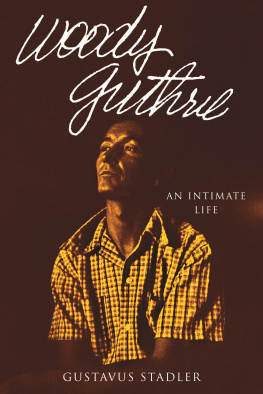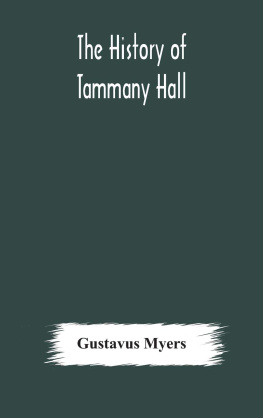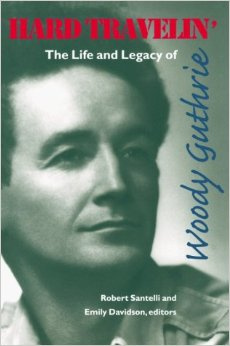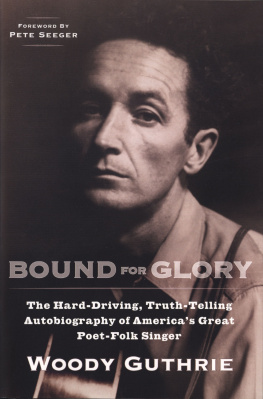Gustavus Stadler - Woody Guthrie: An Intimate Life
Here you can read online Gustavus Stadler - Woody Guthrie: An Intimate Life full text of the book (entire story) in english for free. Download pdf and epub, get meaning, cover and reviews about this ebook. year: 2020, publisher: Beacon Press, genre: Non-fiction. Description of the work, (preface) as well as reviews are available. Best literature library LitArk.com created for fans of good reading and offers a wide selection of genres:
Romance novel
Science fiction
Adventure
Detective
Science
History
Home and family
Prose
Art
Politics
Computer
Non-fiction
Religion
Business
Children
Humor
Choose a favorite category and find really read worthwhile books. Enjoy immersion in the world of imagination, feel the emotions of the characters or learn something new for yourself, make an fascinating discovery.
- Book:Woody Guthrie: An Intimate Life
- Author:
- Publisher:Beacon Press
- Genre:
- Year:2020
- Rating:5 / 5
- Favourites:Add to favourites
- Your mark:
- 100
- 1
- 2
- 3
- 4
- 5
Woody Guthrie: An Intimate Life: summary, description and annotation
We offer to read an annotation, description, summary or preface (depends on what the author of the book "Woody Guthrie: An Intimate Life" wrote himself). If you haven't found the necessary information about the book — write in the comments, we will try to find it.
Woody Guthrie: An Intimate Life — read online for free the complete book (whole text) full work
Below is the text of the book, divided by pages. System saving the place of the last page read, allows you to conveniently read the book "Woody Guthrie: An Intimate Life" online for free, without having to search again every time where you left off. Put a bookmark, and you can go to the page where you finished reading at any time.
Font size:
Interval:
Bookmark:


For my parents
O NE EVENING IN MARCH 1942, Woody Guthrie strolled into a small New York dance studio and sat down on a folding chair. As he pulled the strings of his guitar into tune, he watched a small group of dancerseight women and two menstretching and twisting themselves effortlessly, bringing home the contrast with his own broken-down physical state: the stiffness in his joints, the smoke-tarred inside of his lungs. The group chatted casually with an ease that belied the bandages and gauze pads covering their knees and ankles.
He knew two of the group before him. One was the ensembles leader, Sophie Maslow, who was surveying the room and getting ready to start the rehearsal. Sophie was the one who had invited him here, just a few days ago. It wasnt the type of thing hed ever done, but the decision to participate was a fairly easy one. Shed already choreographed a couple of solo pieces based on his Dust Bowl Ballads recording from 1940. Her previous works as a choreographer were tributes to the Soviet Union, a nation whose social and political structure both she and he were given to describing in idealistic, utopian terms. And her idea for this piece sounded good to him: dances, based on folk forms, to traditional American songs, along with excerpts from the earthy poetry of Carl Sandburg. She wanted Guthries guitar to accompany the group shed assembled, made up of dancers moonlighting from established companies; Sophie herself, for instance, danced in the illustrious, artistically groundbreaking Martha Graham Dance Company. In between dance numbers, the plan was for Guthrie and another musician to act out comic dialogues and sketches, highlighting the folksy wit and wisdom with which hed built a following on both radio and records, first in Los Angeles in the late 1930s, and now in New York and beyond.
Sophie called everyone to order and nodded at him. The first number in the piece, titled Folksay, was the traditional I Ride an Old Paint, a staple of his repertoire, of everyones repertoire. He started to strum the simple chord progression. The dancers, dressed in denim, plaid shirts, and cowboy hats, began to move, directed by some graceful, invisible muse. Then something in the atmosphere changed. One young woman hesitated, then quickly recovered. But a couple of seconds later, another girl got stuck waiting for Guthrie to deliver a beat that arrived just a split second late. She tripped, cursed, giggled a little along with the others. Maslow, worried about time, suppressing annoyance at the guitarists sloppiness, called them back into order.
He began to run through the chords again, wondering if the cocky grin hed summoned had succeeded in hiding that he was nervous and scared. Things started out better. It was such a simple song. Hed played it hundreds of timesat parties in north Texas, in clearings among tents of exhausted workers in California migrant camps, at hootenannies full of beer-soaked communist intellectuals in Los Angeles. And now here in New York City, wherebut suddenly, a clatter of colliding limbs, and someone was splayed on the floor. This time, there was no laughter, just looks of concern and, hes afraid, some scowls in his direction. They were probably wondering how it could be so hard to play such a simple song at an even tempo. They might even be thinking he was a fraud. Why not just dance to records if it was going to be this much trouble, if people were going to get hurt? All the camaraderie and ease of minutes ago had dissolved, it seemed. Sophie might have already been considering other guitar players.
When he had arrived at the rehearsal, he had recognized one person in the room other than Maslow, and now she was approaching him. People here called her Margie. She had introduced herself as Marjorie Mazia when she and Maslow had shown up unannounced a few nights earlier at the house he was sharing with a group of politically like-minded musicians called the Almanac Singers. Like Maslow, Mazia had been taken aback by Guthries Dust Bowl Ballads. In those 1940 recordings, both young women heard echoes of the Yiddish songs their parents sometimes sang to them as children, laments for a people that, just like the Dust Bowl victims, were made homeless by greed and exploitation. It made them feel a connection with a population theyd barely known existed.
Walking over to the singer, Margie held something in her hand: a stack of what looked like those cardboard cards that come in new shirt packages. Smiling, radiant, looking sharp-eyed but reassuring, she sat down on the floor in front of him and began to write numbers and cues on the cards. Now Woody, she said, if you can count, you can do this.
That night in the dance studio, as Guthrie tried to do his part to assist Maslows company in their endeavor, he required help achieving a more literal, microcosmic version of what his songs and writing encouraged others to do: get organized, become part of a planned movement, join in a united, collaborative process. And yet this personal interventionin a scene of poor timing, disorder, bodies made vulnerablehelped set Woody Guthries life on a new course. Its a story that both Woody and Marjorie retold many times over the course of their lives, one that their daughter, Nora Guthrie, calls a part of our family lore. Fundamentally, it reflects the clash of two ways of keeping time, the loose and improvisational rhythms of folk music at odds with the intricate, precise timing of modern choreographyan unlikely alchemy with which not only Maslow but Martha Graham and other eminent modernists were experimenting. But as a family legend, it describes an inaugural act of intimacy, an unsolicited but much-needed offer of care in a moment of helplessness. Woody Guthries fascination with the revolutionary potential of intimacy, honed during a lifetime of contact with fragile bodiesincluding, just a few years after this dance rehearsal, his ownis the subject of this book.
It shouldnt come as a surprise that dance would be an arena of significant anxiety for Woody Guthrie. The slight man sitting on a folding chair with a guitar, struggling to hide his shame, knew very well that human bodies are precarious things, and that, consequently, they make us need the intimate care and attention of other people. That awareness filled his original songs, like the ones Maslow and Mazia had heard on his record, in which he described the human wreckage caused by dust storms, floods, and other natural catastrophes whose impact increased proportionally with the poverty of the people affected; it was in his persistent attention to the predations of capitalism, and the damage routinely done to workers laboring in substandard, even dangerous conditions. He knew the violent blowback they could expect from their bosses when they banded together as a group to seek a fair share of their labors rewards, or a healthier working environment. He had sung about it in songs like Dust Pneumonia Blues, Dust Cant Kill Me, Hard Travelin, and many more.
Born in Oklahoma in 1912, Guthrie had grown up on soil with a deeply rooted history of vicious, unrepaired violence. Before being granted statehood in 1907, the region was initially designated as Indian territory, a place for the federal government to stow several nations of indigenous people forcibly uprooted from their land in the South and Southeast in order to open up vast swaths of the continent for the use and profit of white settlers. On May 31, 1921, sixty miles north of Guthries hometown of Okemah, hundreds of white Tulsa residents launched a quasi-military assault on the Black neighborhood of Greenwood, dropping bombs from the air, setting buildings on fire, killing as many as three hundred people and razing the prosperous area once known as Black Wall Street. More locally, in 1911, the year before Guthries birth, Okemah had been the site of a brutal lynching, in which a Black mother and son, Laura and L.D. Nelson, accused of killing a white police officer, were seized from a jail and hanged from a bridge over the Canadian River just south of town. Although no documentary evidence can confirm it, in the late 1970s, Guthries uncle Claude told biographer Joe Klein that Charley Guthrie, Woodys father, was a member of the lynching party. He was a Democratic Party operative in the South and, by virtue of having that role, almost certainly a white supremacist; some biographers suspect he was an active member of the Ku Klux Klan. He wrote reactionary articles for the
Font size:
Interval:
Bookmark:
Similar books «Woody Guthrie: An Intimate Life»
Look at similar books to Woody Guthrie: An Intimate Life. We have selected literature similar in name and meaning in the hope of providing readers with more options to find new, interesting, not yet read works.
Discussion, reviews of the book Woody Guthrie: An Intimate Life and just readers' own opinions. Leave your comments, write what you think about the work, its meaning or the main characters. Specify what exactly you liked and what you didn't like, and why you think so.






